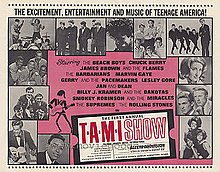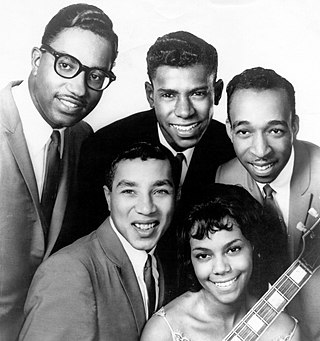
The Miracles were an American vocal group that was the first successful recording act for Berry Gordy's Motown Records, and one of the most important and most influential groups in the history of pop, soul, R&B and rock and roll music. The group's international fame in the 1960s, alongside other Motown acts, led to a greater acceptance of Rhythm & Blues and pop music in the U.S., with the group being considered influential and important in the development of modern popular music.
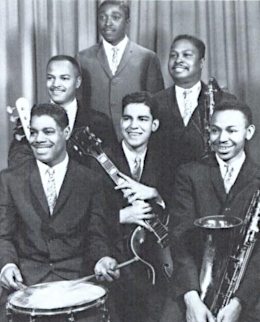
The Funk Brothers were a group of Detroit-based session musicians who performed the backing to most Motown recordings from 1959 until the company moved to Los Angeles in 1972.

Motown 25: Yesterday, Today, Forever is a 1983 television special, produced by Suzanne de Passe for Motown, to commemorate its 25th anniversary. The program was taped before a live audience at the Pasadena Civic Auditorium in Pasadena, California on March 25, 1983, and broadcast on NBC on May 16. Among its highlights were Michael Jackson's performance of "Billie Jean", Smokey Robinson's reunion with the Miracles, a Temptations / Four Tops "battle of the bands", Marvin Gaye's inspired speech about black music history and his memorable performance of "What's Going On", a Jackson 5 reunion, and an abbreviated reunion of Diana Ross & the Supremes, who performed their final #1 hit, "Someday We'll Be Together" from 1969. The show was written by Buz Kohan, Ruth Robinson, and de Passe.

"Ain't That Peculiar" is a 1965 song recorded by American soul musician Marvin Gaye for the Tamla (Motown) label.
"Hitch Hike" is a 1962 song by Marvin Gaye, released on the Tamla label. Another song Gaye co-wrote.

"You've Really Got a Hold on Me" is a song written by Smokey Robinson, which became a 1962 Top 10 hit single for the Miracles. One of the Miracles' most covered tunes, this million-selling song received a 1998 Grammy Hall of Fame Award. It has also been selected as one of The Rock and Roll Hall of Fame's 500 Songs that Shaped Rock and Roll. It was recorded by the Beatles for their second album, With the Beatles (1963). Many other musicians also recorded versions.

Warren Thomas "Pete" Moore was an American singer-songwriter and record producer, notable as the bass singer for Motown group the Miracles from 1955 onwards, and was one of the group's original members. He is also a 2012 Rock and Roll Hall of Fame Inductee, and a BMI and ASCAP award-winning songwriter, and was the vocal arranger on all of the group's hits.

Pure Smokey is Smokey Robinson's second post-Miracles album, released in 1974. It features the single "Virgin Man." Several songs were written by Robinson with fellow Miracle Marv Tarplin, who left the group a year after Robinson's departure to join him in California and assist him in his solo projects.

Love Breeze is an album by the American musician Smokey Robinson, released in 1978. It was arranged by Sonny Burke. It peaked at No. 75 on the Billboard 200.

Make It Happen is a 1967 album by Smokey Robinson & the Miracles. It featured ballads such as the hit singles "The Love I Saw in You Was Just a Mirage" and "More Love", as well as the up-tempo "The Tears of a Clown" co-written by Stevie Wonder and his producer Hank Cosby.

Time Out for Smokey Robinson & the Miracles is a 1969 album by Motown group The Miracles. It reached #25 on the Billboard Pop Album chart, and contains four pop top 40 singles – "Doggone Right", "Abraham, Martin & John", "Here I Go Again" and the top ten pop smash hit "Baby, Baby Don't Cry". Time Out also features covers of Motown songs such as "For Once in My Life" and the Robinson-penned songs "My Girl" and "The Composer". Miracles members Marv Tarplin, Pete Moore and Ronnie White were also co-writers on several of the album's tracks, along with Motown staff songwriters Al Cleveland, Ron Miller and Terry Johnson. Miracle Pete Moore also co-produced two of the album's tracks, a prelude to his later production of the Miracles' massively successful platinum-selling City of Angels album of a few years later. The Miracles' Time Out album was originally released on CD in 1986, and again in 2001 coupled with their album, Four in Blue.

Marvin Tarplin was an American musician, best known as the guitarist for the Miracles from the 1950s through the early 1970s. He was one of the group's original members and co-wrote several of their biggest hits, including the 1965 Grammy Hall Of Fame-inducted "The Tracks of My Tears". He is also a winner of the BMI Songwriter's Award, and the ASCAP Award Of Merit, and was a 2012 posthumous inductee into the Rock and Roll Hall of Fame with the Miracles.
"My Girl Has Gone" is a 1965 R&B single recorded by The Miracles for Motown's Tamla label. Included on their 1965 album Going to a Go-Go, "My Girl Has Gone" was the follow-up to the group's number 16 Billboard Hot 100 million-selling hit "The Tracks Of My Tears".
"Mickey's Monkey" is a 1963 song recorded by the R&B group the Miracles on Motown Records' Tamla label. It was written and produced by Motown's main songwriting team of Brian Holland, Lamont Dozier, and Eddie Holland, who later went on to write two more Miracles hit singles, the Top 40 "I Gotta Dance to Keep From Crying", and the Top 20 "(Come 'Round Here) I'm The One You Need". This was an unusual writing situation for the Miracles, as most of their songs were composed by the group members themselves.

What Love Has...Joined Together is a 1970 album by R&B group Smokey Robinson & The Miracles on Motown Records' Tamla label. A concept album consisting solely of six short love songs, it charted at number 97 on the Billboard Top 200 Album chart, and reached the Top 10 of Billboard's R&B album chart, peaking at number 9. It was the first Miracles album to have no new songs; the recordings are all cover versions of songs written by noted composers, such as Stevie Wonder, Berry Gordy, Frank Wilson, Brenda Holloway and her sister Patrice Holloway, Burt Bacharach and Hal David, Marvin Gaye, The Beatles' John Lennon & Paul McCartney,, and Miracles members Smokey Robinson and Bobby Rogers.

Renaissance is a 1973 album by R&B group The Miracles on Motown Records' Tamla label. It was the first album by the group not to feature original lead singer Smokey Robinson on lead vocals, instead featuring him as executive producer. Robinson was replaced by lead singer Billy Griffin.
"That's What Love Is Made Of" is a 1964 hit song by Motown's original vocal group, the Miracles, issued on the label's Tamla records subsidiary. It was taken from the group's album Greatest Hits from the Beginning, but originally appeared on their abortive 1964 album, I Like It Like That.
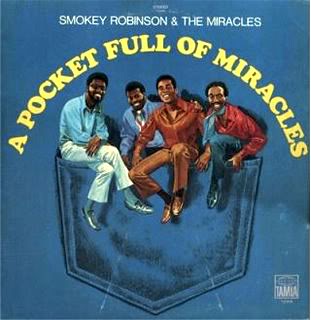
A Pocket Full of Miracles (TS306) is a 1970 album by Motown Records R&B group The Miracles, issued on its Tamla subsidiary label, one of three albums the group released that year. This album charted at #56 on the Billboard pop albums chart, and reached the top ten of the magazine's R&B albums chart, peaking at #10. It was released on September 30 of that year. Hit singles on the album included "Point It Out" and the topical Ashford & Simpson written-and-produced song "Who's Gonna Take the Blame", a sad, dark song about a girl that is turned out as a prostitute. Also included is the charting flip side "Darling Dear", B-side of "Point It Out", which reached #100 on the Billboard pop chart, and spawned a cover version by The Jackson Five.
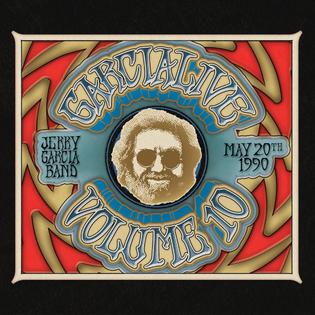
Garcia Live Volume 10 is a two-CD live album by the Jerry Garcia Band. It contains the complete concert recorded on May 20, 1990 at the Hilo Civic Auditorium in Hilo, Hawaii. It was released on February 23, 2018.

"Surfin' U.S.A." is a song by the American rock band the Beach Boys, credited to Chuck Berry and Brian Wilson. It is a rewritten version of Berry's "Sweet Little Sixteen" set to new lyrics written by Wilson and an uncredited Mike Love. The song was released as a single on March 4, 1963, backed with "Shut Down". It was then placed as the opening track on their album of the same name.
